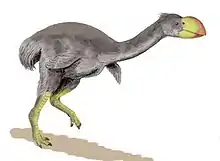Dromornis stirtoni
Dromornis stirtoni, colloquially known as Stirton's thunderbird, a member of the family Dromornithidae, is the second largest flightless bird found through fossil evidence. It was three metres (10 feet) tall and weighed half a tonne (1100 lbs).[1] It inhabited subtropical open woodlands in Australia during the Late Miocene and may have been carnivorous. It was heavier than Aepyornis and taller than the moa. Due to the poor fossil record of Dromornis australis (the type species of the genus) and the large time gap between the two Dromornis species, D. stirtoni may eventually be reassigned to the genus Bullockornis.
| Dromornis stirtoni Temporal range: Tortonian | |
|---|---|
 | |
| Scientific classification | |
| Kingdom: | Animalia |
| Phylum: | Chordata |
| Class: | Aves |
| Order: | †Gastornithiformes |
| Family: | †Dromornithidae |
| Genus: | †Dromornis |
| Species: | †D. stirtoni |
| Binomial name | |
| †Dromornis stirtoni P. Rich, 1979 | |
This species had a long neck and stub-like wings, rendering it flightless.[2] Its legs were powerful, but it is not believed to have been a fast runner.[2] The bird's beak was large and immensely powerful, leading early researchers to believe that it was used to shear through tough plant stalks.[2] However, recently others have argued that the size of the beak suggests that the bird was a carnivore.[2]
The only recorded location of the species is at Alcoota Station in the central region of Australia's Northern Territory. When she discovered it, Patricia Vickers-Rich named the bird after fellow palaeontologist Ruben A. Stirton.[3]
References
- Musser, Anne (November 2018). "Dromornis stirtoni". The Australian Museum. Retrieved 15 May 2019.
- Ellis, Richard (2004). No Turning Back: The Life and Death of Animal Species. New York: Harper Perennial. p. 102. ISBN 0-06-055804-0.
- " Dromornis Der schwerste Vogel aller Zeiten". GRIN (in German). Retrieved 15 May 2019.
- Rich, P. (1979): The Dromornithidae, an extinct family of large ground birds endemic to Australia. Bureau of National Resources, Geology and Geophysics Bulletin 184: 1–196.